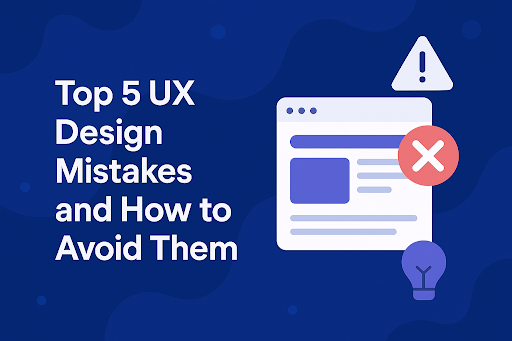In today’s competitive digital landscape, delivering seamless user experiences has become a priority for businesses. A well-designed app can engage users, improve retention, and drive conversions. However, even the most promising apps can fail if they suffer from poor user experience (UX). Many businesses unknowingly fall into common app design mistakes that frustrate users and hurt their brand image.
In this article, we’ll explore the top 5 UX design mistakes you should avoid and actionable tips to overcome them.
1. Overcomplicating the Interface
One of the most common app design mistakes is packing too many features into a single interface. While you may think more features mean better value, an overloaded UI creates cognitive overload and confuses users.
Example: Apps with cluttered dashboards, unnecessary icons, and too many CTAs often leave users unsure of where to start.
How to Avoid:
- Focus on core functionalities first and build around them.
- Use whitespace strategically to separate elements and improve readability.
- Prioritize a minimalistic design that guides users naturally from one task to another.
- Conduct usability testing to see if users can complete key actions without assistance.
A clean, intuitive interface helps users focus on what truly matters, enhancing engagement and satisfaction.
2. Ignoring Platform Guidelines
Every platform-iOS, Android, or web-has its own design principles and user expectations. A major app design mistake is neglecting these platform-specific guidelines. For example, using Android-style navigation on iOS devices can confuse users and lead to poor reviews.
How to Avoid:
- Familiarize yourself with platform guidelines such as Apple’s Human Interface Guidelines or Google’s Material Design.
- Keep navigation, gestures, and UI components consistent with the platform’s standards.
- Test your app on multiple devices to ensure compatibility and native feel.
Staying aligned with platform norms ensures your app feels natural and intuitive for users.
Complex or unintuitive navigation is a critical UX flaw. If users cannot find what they’re looking for quickly, they’ll abandon your app. This is among the most damaging app design mistakes, especially in apps with multiple sections.
How to Avoid:
- Use familiar navigation patterns such as bottom tabs or hamburger menus for easy access.
- Keep navigation labels short, clear, and descriptive.
- Provide breadcrumbs or progress indicators in multi-step processes (e.g., checkout).
- Conduct A/B testing on different navigation flows to see what works best.
Efficient navigation ensures users stay engaged and reduces frustration.
4. Neglecting Accessibility
Accessibility is often overlooked in UX design, but failing to make your app usable for all audiences is a costly app design mistake. People with visual impairments, motor limitations, or cognitive differences should also be able to use your app comfortably.
How to Avoid:
- Follow WCAG (Web Content Accessibility Guidelines) for contrast ratios and font sizes.
- Include screen reader compatibility and text alternatives for images.
- Enable adjustable font sizes and provide accessible color schemes.
- Ensure interactive elements like buttons are large enough to tap easily.
Prioritizing accessibility not only expands your user base but also strengthens your brand reputation.
5. Skipping User Testing
Perhaps the most fatal app design mistake is neglecting usability testing. Even the best-looking designs can fail if they don’t meet real user needs. Skipping testing means you rely on assumptions rather than actual data, which often backfires.
How to Avoid:
- Conduct usability testing early and throughout development.
- Use prototypes or wireframes to gather feedback before full-scale development.
- Observe how users interact with your app and note pain points.
- Continuously refine based on user feedback and analytics (e.g., drop-off points in user flows).
Regular testing helps you catch issues early, save development costs, and ensure your app meets user expectations.
Conclusion
Avoiding these app design mistakes is crucial for building intuitive, engaging, and successful applications. By simplifying your interface, adhering to platform guidelines, streamlining navigation, prioritizing accessibility, and investing in user testing, you can deliver a polished UX that keeps users coming back.
In today’s competitive market, UX isn’t just a design element-it’s a strategic advantage. Remember: good design isn’t just about aesthetics; it’s about usability, accessibility, and user satisfaction.


